Pistons Pop, Valves Vacillate, Gears Grind
It seems like forever ago that I nursed the broken and battered Amazon off my trailer and into Rob's garage. With nonexistent brakes, I had to be so very careful to keep it under control, and not go crashing headlong into expensive and hard things. With the mangled exhaust and year-old gas stagnating in its tank, the engine ran, but not happily. A little over three months have passed since the day the Volvo took up its new residence here, eschewing my dirt floor barn for the hard, solid concrete floors of my teammate's home in Suburbia. Once inside the safe confines of the car-hole, the jackstands went under it, and the wheels came off.
And that's how it was, until last Saturday.
As some of you may remember (or, if not, go back to the main page or "External Links" and click on the link to last year's build-up) we very nearly completely disassembled the 122 prior to putting it all together for the 2008 race. This year was not much different. The fenders, hood, and much of the underside came off. The rear axle stayed in, but all its components- diferential, axles, pinion and bearings- were removed for inspection and replacement, as required (under the Geneva convention, I'm pretty sure). Most of the front suspension was removed- some of it by force, due to a bit of damage- and the fuel system was gutted.
Despite starting 2009 with what was essentially a LeMons-ready car (at least as far as the rules were concerned; it had a cage and most of the requisite safety gear) it was, in our minds at least, no where NEAR competitve. A quick glance back through the work we've done in the past 3 months shows the extent to which we desired to improve our ride. Lower gears, lowered suspension, new exhaust, and renewed components wherever there was wear or damage. And ALL of this was done, it must be stressed, under our $500 budget cap. How? We replaced dollars and sense (pun intended) with blood and sweat. And cursing. Yup, lots of cursing. Several times we told each other "Hey, you know, we could just pay someone $100 and I bet they'd do it for us", or "That special tool will only cost $40, why don't we just buy it?" But that wouldn't be in the spirit of the event. We love this race, and with that admiration for what its all about comes a certain respect for the rules of the game that have been set out.
This is below low-budget racing. Low budget racing is when you have a rebuilt engine, maybe a few spare rears, and a couple professionals on call to help you set up the hard stuff.
We have an engine we still haven't even taken the valve cover off of, a transmission that "sounds good enough", and whenever we encountered something that we should have probably called a professional for help with, we just plowed ahead with the blind faith that we'd figure it out. And we have, thus far, *knock on some serious wood*. Our technical prowess is apparently only surpassed by our cockiness and ignorance. Like Wile-E-Coyote as he speeds headlong off a cliff, we won't fall- because we haven't heard of gravity. "Meep Meep" my ass.
As Kid Rock said, "It ain't braggin' if you do it and you back it up." OK, so that's the Radio Edit version. The point is...the point is...what the heck was I saying? Oh yeah. Backing it up. Or, rather, driving it out of the garage. Which is exactly what we did this Saturday- after the typical hodge-podge of minutia had been attended to. For instance, we finally changed the oil filter, which apparently had not been done last time as it was "stuck":
There's a reason you're not supposed to install oil filters more than hand tight. The gasket was compressed so much, the filter was _almost_ touching the block. Luckily, Anthony has small, powerful hands and a reckless disregard for his spine, contorting himself in numerous indescribably positions under the engine. We jabbed a few screwdrivers through it, and managed to extract the mangled canister.
The fuel line ran, the fuel cell in place, the brakes bled, the rear end put back in one piece, and four of last year's tires bolted in place, we were thusly confronted with the question that all groups of gearheads encounter when they find themselves face-to-face with a ready-to-try-it-out vehicle.
Who's gonna start this thing?
We all agreed it should be someone who drove last year, so they'd have something to compare it to. Brian wussed out, because he said if his wife found out he'd driven a car with no insurance and no registration on a street, any street, even the cul-de-sac in front of Rob's quiet Suburban home, she'd likely saw off his legs. Rob didn't want to, since it was his neighborhood. And since Jamie had left for the day, and Matt was still in New York, that left, um, yeah...
So I hit the starter button. The engine backfired. Fiddling with the distributor and having brave (foolhardy) Brian and Rob spraying starting fluid into the gaping maws of the SU carburetors, we managed to blow a shot through the exhaust that reverberated throughout the neighborhood. I'm pretty sure the shockwave broke glass. But still, no vroom vroom. I suspected the timng was off- way off- so Anthony and I went about finding TDC on cylinder #1 and, sure enough, while the distributor cannot be put in backwards, Rob, our Master Electrical Guy *cough cough* had wired the plug wires in 180 degrees out. We refitted them in the proper orientation, making sure to keep the 1-3-4-2 firing order straight, and prayed we hadn't blown anything internal apart. This is the last time we let someone whose formative experiences with automotive electrics were on British cars have charge of anything vaguely electrical on the Volvo.
Crankacrankacrankacranka-sputtersputtersputter-vavavavaroooOOOOOOMMMM!!!!!!!
Now, as compensation for you putting up with my extensive verbosity, I give you this movie, which Gary took, of the Tunachucker Volvo actually motoring out of Rob's Black Hole of Automotive Sorrow, under its own steam:
You will note the horrible screeching noises and copius blue smoke. The former is a result of someone (me) installing the exhaust clamps so that the u-bolts were facing down, and thus were approximately 3/4" off the ground with our new fancy lowered springs. The latter is a result of someone else (Jamie) spilling oil all over the engine when attempting to get some into the fill hole (which is only about 4" in diameter)
As you can tell, the cars runs and sounds great. The rear gears that we'd so carefully installed were awesome- no weird noises, and the 20% lower gear ratio really give a lot of grunt off the line. I pulled it all the way through 3rd gear, and it was just-plain-fun to drive. Also, we installed (temporarily) a wide-band O2 sensor, so we could see how well the old British Fuel Atomizers were doing their job. As any good chemistry buff will attest to, the optimal air/fuel ratio in a gasoline engine is 14.7:1. However, in real life its usually better (at least for racing) to run a richer (more fuel) mixture. Leaner mixtures tend to burn hotter, and richer mixture run cooler plus tend to give more POWAH!. Our SUs gave idle readings of around 11:1. But idle is fairly irrelevant- we hope to NOT be idling around the track in April. When I was on the gas, the readings ranged from 12.5 to 13.5:1- a bit on the rich side, but acceptable. Meddling with the buggers might provide, um, undesireable results, and we didn't really feel like the engine was down on power last race. Nor was it coughing up unacceptably large clouds of black carbon soot.
You didn't think I'd write all this and just have _one_ video of the car, did you? Here's me, again, testing out the car's phenomenol new suspension. Or, rather, its phenomenol cobbled-together-bits-from-last-year's suspension.
Either way, it works MUCH better than it did last year at keeping the rear inside tire on the ground and keeping the door handles OFF the ground. Anthony then tried his hand at the tiller:
Anthiny drove a little more conservatively than I did, since he'd never had a turn behind the wheel of an Amazon, any Amazon before. But he seemed to like it. And he seemed good at it.
We have a bit more work to do- tidying up the exhaust so it doesn't drag on the tarmac:
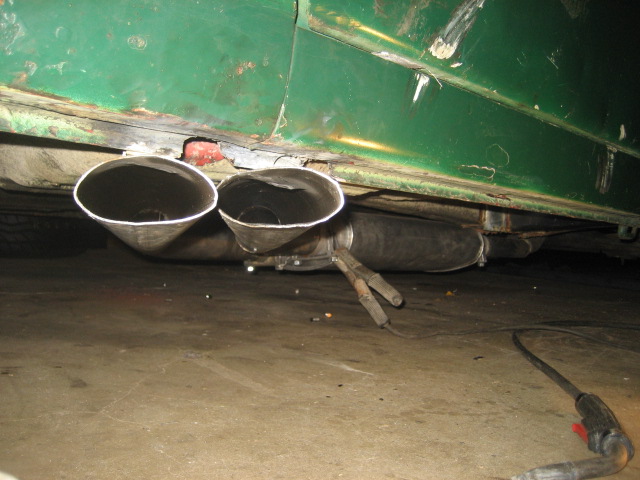
finishing the fuel cell install, and running a brake light- and the weekend after next we plan on trying it out at a local abandoned parking lot. Then we'll REALLY get a chance to see what the new, improved Tunachucker Volvo can do. Stay tuned...race day is April 4th- barely 2 weeks away!
The next weekend...
Ok, I wrote basically this same paragraph once before, and somehow it mysteriously disappeared. If that happens again I'm going to really suspect I'm being edited by the website provider. You see, I migrated over to this place (www.1and1.com) for internet services when the free provider the Tunachuckers used in our inaugural year decided to change to a wiki-style format that, frankly, I hated. Unfortunately, and unbeknownst to me until recently, 1and1 limits the number of pages under a single URL to 10. Why, I have no freaking clue, though I plan on calling them eventually and seeing what's what. But, absent my hosting the site my own damn self (which would require many hours of learning HTML and website hosting and NOT working on the race car) Tunachuckers is going to stay here, at least for the time being. And, at least we have www.tunachuckers.com instead of the somewhat more esoteric "http://tunachuckers.googlepages.com", which required me to repeat the phrase "There's no triple-w in front of that" more often than I'd ever hoped to in my life.
ANYWAY....the long and the short of all that is that the rest of the updates on the car will be tacked onto the end of this page, as I'm rapidly reaching the quota of allowed pages within the site. So keep checking back to "Fire it Up" and scroll down for what's new. I realize that will make this page large, unwieldly, and, for those of you too broke-ass to afford a decent ISP, slow to load, but I'm sorry. Bitch to 1and1.
Back to car stuff...we're getting down to the wire, only about a week now before we head off to CMP and spend the long weekend sleeping in our trucks and tents and hoovering down greasy-ass Bar-B-Que and Cook Out. As such, the work sessions seem to be involving even more chaos than usual, as the 4 or 6 people who show up end up working on completely different crap. Heck, this past weekend (March 21rst-ish) both Brian AND I brought our welders, we had an air compressor going, and with all the drop lights and all I'm surprised Rob's house's electric meter didn't spin a bearing. One improvement we made over last year was the addition of a superior cold-air intake setup. Last year, in the rush to make the race, we cobbled together a rudimentary device comprised of an aluminum box sandwiching in the air filters, and some cheap ductwork. It was incredibly ungainly, and was tossed asunder the first time we had to monkey with the carburetors during the race. This year, we desired something equally cheap, but better engineered. We started off by tack-welding this flange to the former heater/ cowl air intake:
Also, notice Rob's color-coded wiring and terminal block, to the right. Roughly, the color coding goes as follows: If the wire is colored, there is some amount of current going through it at some point. If the wire is black, it (hopefully) connects to ground.
Getting back to the cold air box, a split plenum was needed to divert the incoming air into the twin SU carburetors. More dryer ductwork and some old exhaust pipe welded to a flange fit the bill, and JB weld neatly sealed the connections:
The nice thing about this setup is that it is easily removed, and allows access to tickle the SU carbs somewhat without even doing that. After doing some research, we decided to go with a "bugs and boulders" air filter: that is, the cowl screen. Barring an unforeseen sandstorm in central SC in early April (an unlikely occurrence, except in cases of extreme apocalypse), the screen should filter out anything that will likely damage the engine. Oh, yeah, and its a Volvo Red Engine. You can pretty much feed them stone dust and tungsten shavings and they'll still run.
To prove the superior flow rate of the New and Improved Dinan-quality cold air intake, Brian provided his best impersonation of an 1800 cc pushrod engine:
Last year, I tried this on a muffler. Brian didn't get as much soot in his mouth.
Much more welding was required on the car. Up front we had to reinforce the weakened and broken bumper mounts. We decided, after much hand-wringing and effort on Brian's behalf, to ditch the old bumper and weld on a piece of C-channel. It'll be stronger, and look meaner. It also meant a hit of a few dozen dollars to our budget, which luckily had been bolstered recently by the sale of the old gears from the differential. (Which means, if you don't count the scores of hours and thousands of brain cells expended on swapping the gears, the rear end ratio change was basically free) Here, Brian and Anthony work on this project:
As I mentioned above, this was a Multiple Welder Saturday for the Tunachuckers. While Brian and Anthony labored on the front of the car, I busied myself plugging up the holes in the back, er, "firewall", that the safety inspectors would assuredly fail us on during this year's more stringent pre-race lookover.
When working in the back of a cage-equipped car, you soon begin to understand what it'd be like to be the inhabitant of a zoo. I quickly discovered that the quickest way to insert and extract myself bodily from the car was through where the back glass used to be.
Unfortunately, while welding up the gaps in the rear deck, some weld spatter haphazardly ended up in the trunk...where the fuel cell and some nice greasy rags were. Luckily, the blaze was easily controlled. I have only this photo of the aftermath, smouldering. Even so, Rob jokes he was diving for the fire extinguisher while I was grabbing my camera to take a picture of his garage exploding with us in it. Rob likes to exaggerate, slightly.
There, that outta protect it (or, at least, keep the satellites from reading its thoughts):
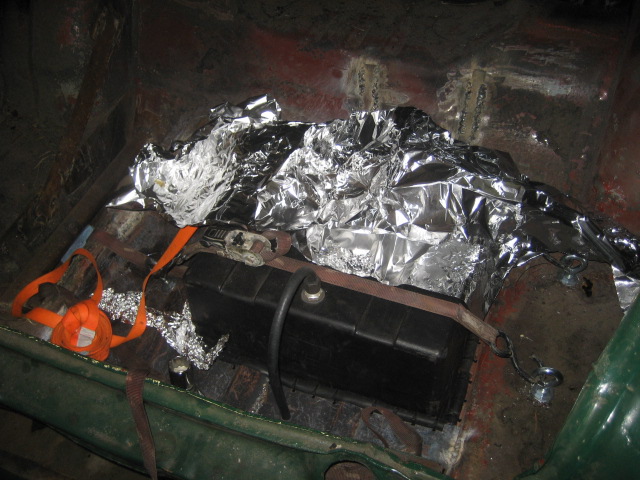
Despite having the advantage of a gas-shielded welder, the bumper bracket welds didn't look appreciably better than my flux-core welds on the back of the car. I attribute this to my mad welding skills. But, admittedly, i have owned my welder for about 11 years, and have welded everything from differential covers to carousels, in nice, well-lit metal shops, grungy garages, and the dusty desert. Brian just bought his welder a few months ago. To his credit, he at least sprung immediately for the gas conversion, while I only procured mine a few years ago. And my CO2-Argon tank sits at home, empty.
The bumper bracket:
Having hammered out the dinged-up front wings into a shape loosely resembling those of a 1966 Volvo Amazon a few weeks ago, Brian cut out some old dog cage grate and recreated the mean-looking headlight grilles. I love these- they give the 122 _presence_.
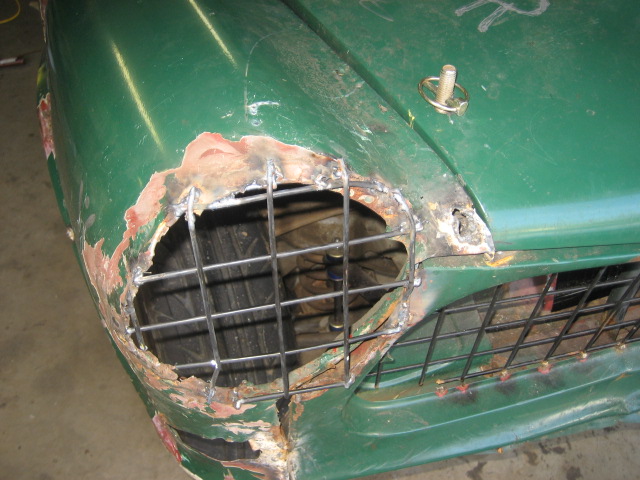
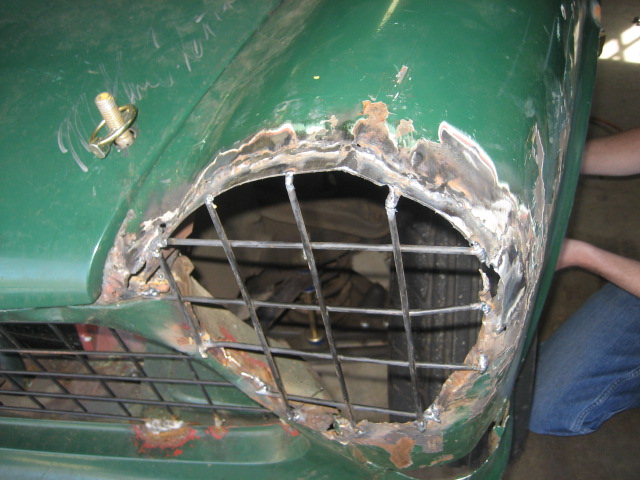
Rob, who we continue to allow to work on the electrical system (such as there is one) despite having caused more smoke and flame incidents with a 12 volt battery than either Brian, Anthony, or I have with the MIG welders, took on the task of tidying up the snake's den of wires, and installing a new feature for this year: a low-oil pressure light. This red light, grabbed from the discount bin of cheap-ass trailer lighting at a truck stop, will illuminate if the engine is off, or if the oil pressure drops below some level. What this level is, we're not sure. Its preset into the switch. We eschewed the idea of an actual oil pressure gauge; for one, the added cost and complexity offered one more system to fail, potentially catastrophically (hot oil leak in the cabin). For another, in high-ish speed wheel-on-wheel racing, the driver needn't be distracted by all sorts of fancy ricer-boy gauges. If something flashes red, there's a problem, that's all he needs to know. Bring it in and shut it off.

Another new-for-2009 "safety" rule is the At Least One Working Brake Light requirement. Jamie, who has a somewhat better working relationship with positrons than does Rob, spent a good amount of time cleaning and fixing up a dilapidated Amazon taillight so that all three bulbs would fire when the brakes were engaged. For redundancy. He had to leave before completing the work, but on the following Wednesday's work night Anthony finished it up.

The suspension tweaking never ends! This week's episode involves the measuring and setting of toe, camber deliberations, and preventing the rear axle from spitting out springs around hard corners. First things last: with the shortened springs all around, the potential exists for one or both of the rear coil springs to jump out of their perches around a hard corner with copious body roll. The solution? Do what Volvo did- install straps to keep the axle from drooping below the point at which the spring would become loose. While new limiting straps are still available for purchase, we, of course (true to Tunachucker and LeMons tradition) took the ultra-cheap (read: free) route by having Anthony swipe a rejected, damaged nylon lifting strap from the scrap bin at work and slicing it into usable sections. The strap is sandwiched between two flat plates on the car body and the axle, and a bolt retains each end. Here's the before and after:
Crappy, broken:
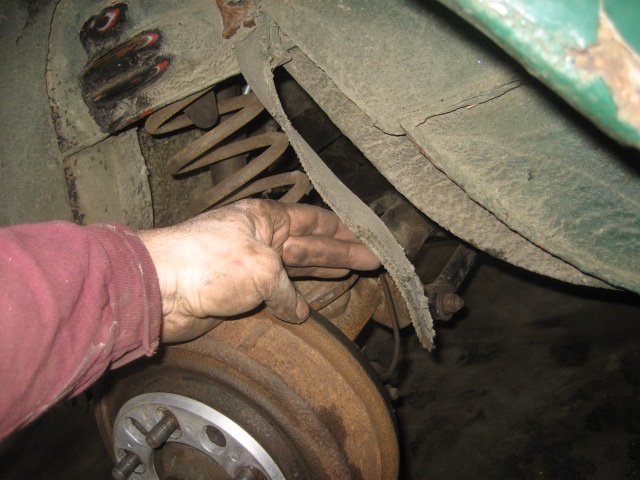
New, cheap:
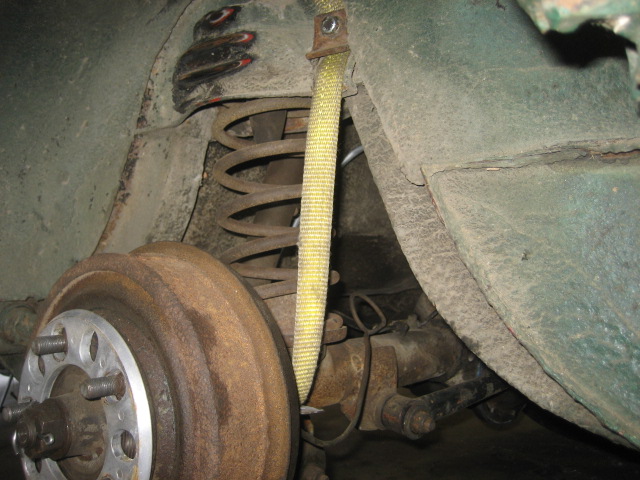
As for the front suspension, we took measurements and determined the toe was about 1/2" out. That is, the front wheels were pointing slightly apart. While this makes for quicker turn-in, too much can be unstable and also lead to excessive tire wear. Since the steering on the Volvo consists of about 3 dozen small linkages bound together with old grease and Swedish prayers, it seemed likely that a static toe-neutral condition would result in a dynamic toe-out, slightly, while driving. So we set the toe as neutral as possible in Rob's garage. If the car turns in too slowly on the track, we can easily add more toe out. 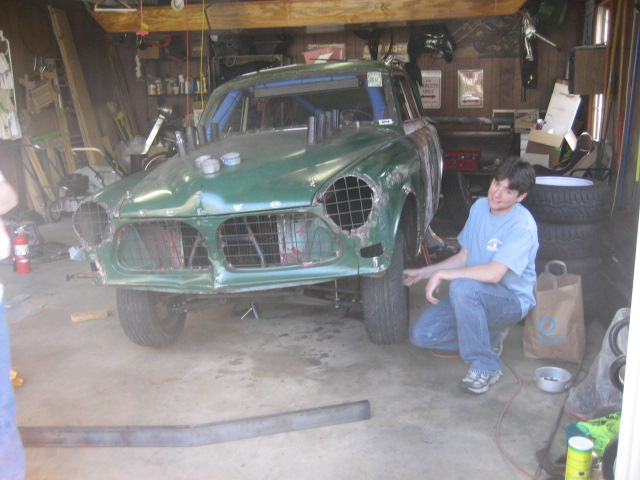
One of the nice things about the completely conventional Volvo suspension is how easily and quickly it can be tuned. This applies not only to the toe, but also to the caster (which we decided to leave as it was, for now) and the camber (which we most assuredly needed more of).
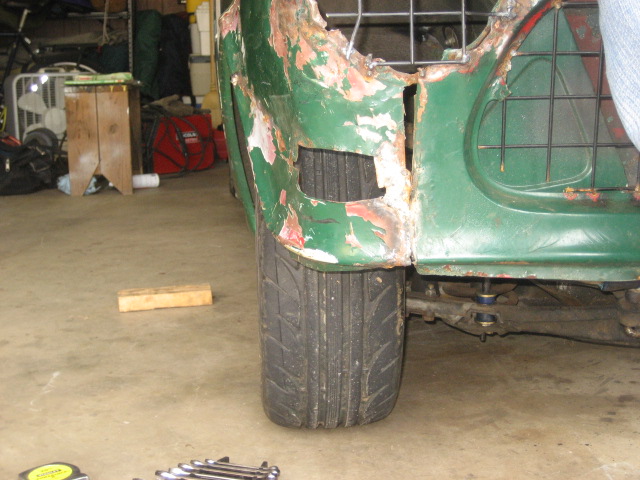
To set the camber, we removed the two bolts at the top A-arm pivot. Since we needed to add about 2 million degrees of negative camber to the front wheels, we had to replace the old camber bolts with longer ones, to fully engage the threads on the mounting boss with the big fat spacers we had envisioned to install. The Ace Hardware up the street supplied some (surprisingly expensive) Grade 8 7/16" UNC bolts for this purpose. I grabbed some aluminum plates of various widths from the metal recycling bin at work, and with Rob's Poor Man's Machine Shop (read: a sawzall, porta-ban, and cheap-ass drill press, and a very wobbly vice- likely imported from the Land of Small Child Labor) the desired camber spacers were fabricated.
Raw Material:

Scraps into something useful:

With the helps of Rob's Exceedingly Accurate Plumb Bob (a metric nut on a piece of twine) and a Hewlett-Packard reverse-Polish scientificky calculator, we set the camber at roughly 1.9 degrees and 3.4 degrees on the right and left sides, respectively. Most of the track's turns will be right-handers, which was the rationale for the bias in camber, but again, this is easily changed should conditions and experience warrant.

More to come! This coming weekend: Fine Tuning and Parking Lot testing here:

Don't forget: The race is in one week! April 4-5 at Carolina Motorsports Park. See you there! Sorry, we _won't_ be racing this:
